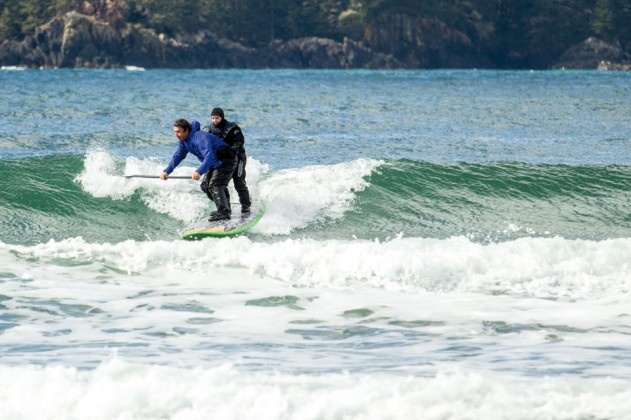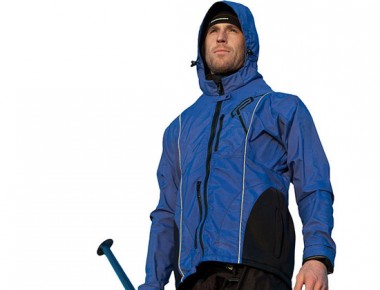Drysuits are finding their way into more corners of the board sport world, but for those that haven’t tried these miraculous thermal solutions some questions hang in the air. We caught up with Ocean Rodeo’s Richard Myerscough to bust a few common myths…
1. A dry suit is slower to don and doff compared to a wetsuit and this eats into session time.
Yes and no. When a wetsuit is damp and cold (second session, not dry from an earlier session) the torture of putting it on can be enough to make you procrastinate from even going out! This one of the main reasons I want to push dry suits in the surf, SUP and kite worlds. Purely selfish as I hate putting on wet cold wetsuits and the restriction of thick neoprene suits! Dry suits take the cold right out of the equation. You show up, conditions looks good, throw on your fleece and dry suit and head out. You don’t think ‘shit it’s’ freezing’; you don’t hide in your car shivering anymore. Perhaps you save time on hesitation, you just go out. I can don my dry suit about the same speed as a modern no zip wetsuit. That’s fully donning the fleece and dry-suit. Wear your fleece to the beach you’ll be faster.
2. Wearing a dry suit will alienate you from the rest of the boardriding world in terms of fashion / style.
This is a funny question! Being alienated if you “wear” something different?! I run into this problem quite often when I go SUPing in the surf – but it’s nothing to do with wearing a dry suit. It’s the standard SUP vs surf or kite vs surfer vs SUP clash. These clashes are related to differences in what we use to ride waves as some people feel threatened by all these new wave riding machines. The territorial surfers will still be throwing hate to a SUPer in the surf regardless of what he’s wearing.
As a side note, I also surf (regular prone) and feel most cold water surfers are interested in where dry suits are heading. Without question, every surfer who spends time in cold water wants to be warmer and have more mobility (look at the recent attempts at electric heated suits) so any attempt to improve what we wear in these conditions is all good.
3. You sink when they rip and let water in.
Water is neutral in water. So, the weight of the water will not pull you down, you’re just swimming in it. I opened up the zip fully on my dry suit dove under tried to fully saturate the suit. The issue with this is climbing out of the water as the legs fill. To deal with this I found I could squeeze the water of the suit by tucking in a ball.
The water doesn’t want to force its way in when the pressures is equal inside and outside of the suit. A suit like our Surf Dry with the outer skin layer has an advantage over single layer bag suits. If a major suit failure occurs the outer skin places external pressure on the dry core, restricting water entry. Water is inert in water, it doesn’t force its way into space pushing against restrictive force like the elasticity of the outer skin. This is why we promote the Surf Dry for use in hard breaking surf over the traditional single layer style dry suit.
In the professional and military sectors (diving, surface swimmers, mini subs etc) wetsuits are basically obsolete. Even the US coast guard rescue swimmers now use dry-suits. The entire maritime safety industry is based on dry suits. It’s now mandatory for all ships to carry survival dry suits for the crew. Really the only market left that hasn’t really accepted the dry-suit is surfing. I intend to change this however!
4. Dry suits are less durable than a wetsuit.
We have customers still using original OR Pyro Pro dry suits approaching 10 years old. They may be on their second or third Latex seal replacement, and have patched a few holes, but the suit core and dry zipper are still going strong. With a dry suit you can maintain the suit and have many years of use. They are easy to patch. Latex seals can also be replaced. Dry zips are also very durable these days, lasting many years if looked after properly.
The newer breathable suits are durable, however not as much as the bi-lam non breathable materials. This is the trade off for the supple breathable material vs the more stiff non breathable PU/nylon dry-suits. We’re seeing a life span of three years on the breathable suits when used all year round.
5. They are more expensive than a good wetsuit.
You get twice the life span of a good wetsuit. You’re warm and dry, and that’s priceless when the weather is really cold. You have more mobility, especially in the shoulders and forearms. You have variable temperature options since you can layer up or down your fleece undergarments to match the temperature. And you simply don’t feel the cold water creep when you’re in the water. DM
More info on the Ocean Rodeo Dry suits here


